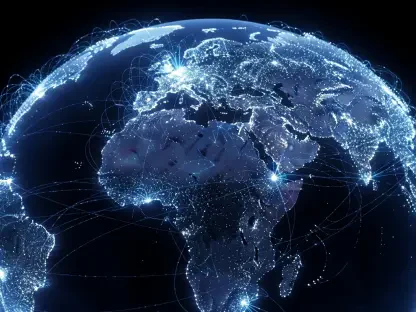In an era where digital transformation accelerates at a relentless pace, the stark reality of cybersecurity vulnerabilities has never been more apparent, with recent data revealing that despite a staggering 93% of organizations boosting their cyber budgets by at least 10%, genuine resilience remains elusive for most. Reports from leading industry sources paint a troubling picture: while financial commitments to security are at historic highs, the gap between investment and effective defense continues to widen. A mere 2% of organizations globally claim full readiness against cyber threats, exposing a critical disconnect that threatens not just data but also reputations and bottom lines. With the average cost of a data breach now hitting $3.32 million, the stakes are monumental. This alarming scenario sets the stage for a deeper exploration into why increased spending fails to translate into stronger defenses, the evolving nature of threats, and the strategic shifts needed to bridge these persistent gaps.
The Investment Paradox
Unpacking the Spending vs. Resilience Disconnect
The surge in cybersecurity budgets across industries has become a defining trend, yet the outcomes remain disheartening, as evidenced by the fact that 70% of organizations linger at beginner or formative maturity levels despite significant financial outlays. This paradox stems from a fragmented approach to investment, where funds are often spread across multiple vendors without a cohesive strategy, leading to inefficiencies in detection and recovery. Financial services and technology sectors show relatively higher maturity, benefiting from advanced tools and compliance frameworks. In contrast, industries like manufacturing and healthcare grapple with outdated systems and regulatory burdens, leaving them particularly exposed. The financial toll is severe, with breaches eroding earnings and trust at an unprecedented scale. This mismatch between expenditure and readiness underscores a fundamental flaw: throwing money at the problem without strategic alignment fails to address the root causes of vulnerability.
Sectoral Disparities and Systemic Weaknesses
Beyond the broad statistics, a closer look at sectoral disparities reveals why certain industries struggle more than others to convert budgets into resilience, with manufacturing and healthcare often lagging due to legacy infrastructure and limited resources for modernization. These sectors face unique challenges, such as operational technology systems that are decades old and incompatible with modern security protocols, making them prime targets for exploitation. Meanwhile, financial institutions, driven by stringent regulations and high-stakes environments, tend to prioritize and integrate security measures more effectively. However, even in advanced sectors, fragmented vendor ecosystems can dilute the impact of investments, as tools fail to interoperate seamlessly. This uneven landscape highlights a critical need for tailored approaches that address industry-specific risks rather than relying on one-size-fits-all solutions, emphasizing that resilience requires more than just financial input—it demands targeted, systemic change.
Evolving Threats and Readiness Challenges
The Rise of Identity-Based Attacks
As cyber threats evolve with alarming sophistication, identity-based attacks have emerged as a dominant vector, with 30% of intrusions now exploiting valid credentials rather than relying on traditional brute-force tactics, signaling a shift in adversary strategies. Infostealers, often delivered through phishing campaigns, have skyrocketed by 84%, flooding underground markets with stolen credentials that fuel further breaches. Ransomware, while still a significant concern at 28% of malware incidents, is increasingly paired with stealthier methods that evade conventional defenses. Geographically, the Asia-Pacific region has seen a 13% uptick in attacks, its role as a global supply chain hub amplifying risks for enterprises worldwide. This trend underscores how attackers are adapting faster than defenses, exploiting human and systemic vulnerabilities with precision, and highlights the urgent need for organizations to rethink their approach to securing access points.
AI and Identity Security Gaps
Compounding the challenge of evolving threats is the glaring lack of readiness in critical areas like identity security and AI adoption, where only 6% of organizations demonstrate maturity in identity intelligence, leaving most dangerously exposed to credential-based exploits. AI-related incidents have affected 86% of security leaders, yet fewer than half of employees understand how adversaries leverage AI tools, revealing a profound awareness gap. Moreover, while 66% of organizations expect AI to reshape cybersecurity within the next year, a mere 37% have implemented safe deployment practices, creating a risky lag in preparedness. Public sector entities fare worse, with 38% reporting insufficient resilience compared to just 10% of large private firms, reflecting resource and expertise disparities. These statistics point to a dual challenge: fortifying identity defenses while ensuring AI integration does not become a liability, a balancing act that demands immediate attention.
Third-Party and Geopolitical Risks
The scope of cyber risks has expanded dramatically through third-party and supply chain vulnerabilities, identified as the top barrier to resilience by 54% of large organizations, illustrating how interconnected systems amplify exposure. Geopolitical tensions further complicate the landscape, influencing cyber strategies for nearly 60% of enterprises, with concerns ranging from intellectual property theft to operational disruptions. Regional disparities add another layer of complexity, as confidence in national cyber resilience remains significantly lower in Africa and Latin America compared to Europe and North America, exposing global enterprises to risks at their weakest links. These interconnected challenges reveal that no organization operates in isolation; vulnerabilities in one region or partner can cascade across networks, necessitating a collaborative approach to strengthen defenses beyond individual boundaries.
Strategic Pathways Forward
Shifting from Spending to Strategy
Looking back, the cybersecurity landscape of recent times was marked by an urgent realization that mere increases in budgets were insufficient, as 78% of organizations had already invested in generative AI, viewing it as both a defensive asset and a potential risk. The focus had shifted toward strategic action, with 63% of firms upgrading platforms and 44% prioritizing skills training to close capability gaps. Solutions like identity-first architectures and vendor consolidation proved effective in enhancing detection and recovery, demonstrating that outcomes hinged on focused efforts rather than scattered investments. Manufacturing, repeatedly the most targeted sector, faced persistent threats to outdated systems, underscoring the consequences of inaction. The lesson was clear: aligning resources with specific, high-impact strategies was the only way to counter sophisticated threats and build lasting resilience.
Building Global and Sectoral Resilience
Reflecting on past efforts, it became evident that addressing readiness gaps required a global perspective, as regional disparities and third-party risks had consistently undermined even the strongest defenses in isolated pockets. Initiatives to foster employee awareness around AI exploitation and identity threats had gained traction, alongside efforts to protect supply chains through rigorous vendor assessments. Strengthening partnerships across borders and sectors emerged as a cornerstone of progress, ensuring that vulnerabilities in less prepared regions did not compromise global networks. The path forward involved not just fortifying internal systems but also investing in collaborative frameworks, sharing threat intelligence, and standardizing best practices. These steps, taken with urgency, offered a blueprint for navigating the complex, interconnected challenges of cybersecurity, paving the way for a more secure digital ecosystem in the years ahead.









